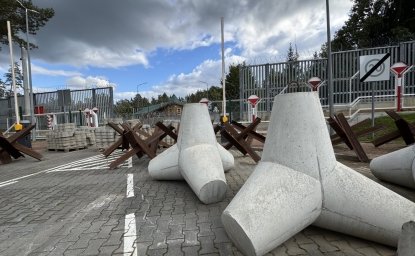By Peter Bean
The field of modern security studies was born during the Cold War, a period during which the structure of international conflict was, by today's standards, relatively simple to understand and navigate for both superpowers. Much of security studies literature has focused on the dynamics of acute rivalry, questions of deterrence, arms control, crisis escalation and management, and causes of war. However, the end of the Cold War ushered the United States into a period of far greater uncertainty, which caused Woodrow Wilson Center Fellow Emily Goldman to ask what the United States' military strategy should look like when "threats are low, when the security environment is uncertain, and when the systemic imperatives of the international system are far more indeterminate."
Goldman points out that the terror attacks of September 11, 2001 were a clear example of why the United States has to think intelligently about an evolving strategic landscape. "Here was something that we never anticipated would happen, but it did happen. The question now is how much do we use that event as a prediction of what's going to happen in the future and how much does it shape the decisions we make now about future contingencies?"
Goldman argues that the United States is currently in the archetypical uncertain international environment. "The Soviet threat is gone and that threat provided the political lodestone for U.S. foreign and security policy for nearly fifty years. Technological advances associated with information technology are in the process of transforming warfare as we know it. We see new forces of ethnic and religious extremism. New actors, non-state actors, that are empowered by globalization and IT are able to inflict pain upon us in a way they could not before—through catastrophic terrorism or through disruption of information systems and the critical infrastructure that under-girds modern society."
Goldman is focused on two large questions. First, how do states manage the uncertainty in their environment? What strategies do they pursue? Secondly, what are the consequences of those choices for their power and their influences? To answer these questions, Goldman is looking back through history at how other political and military leaders have dealt with similar challenges to understand when they have opted to aggressively transform their militaries in response to unclear threats and rapid technological change and how they have balanced the need to respond to present contingencies with the need to prepare for future problems.
Goldman identifies three core problems that U.S. strategic planners face. First, how does one identify future threats and which are most important? How are they likely to arise and at what point? Second, how does one understand the character and the evolution of military technology? What is the direction of technological change? What new combat methods are emerging, who can use them, and how quickly can they diffuse throughout the international system? Third, how does one understand the nature of future warfare? What types of contingencies will the United States face in the future?
To think about strategy under uncertainty, Goldman turned to literature from the field of business management. "As much as the corporate analogy has been adopted by people studying international relations—somewhat problematically, I might add—in this case, I think it's quite appropriate because corporations often have to face a variety of different competitors. There is also a large management literature on the impact of disruptive technologies—technologies that undermine the role of the sustaining leader in a particular industry and how firms need to manage that uncertainty."
Goldman has built upon that literature and argues that there are three strategies that states can pursue under uncertainty: shaping, adapting, and reconstitution. A shaping strategy is designed to alter the strategic environment and drive the system toward a new structure, often through technological innovation. The goal is to change the playing field and set the new terms of competition, and to take the lead in that competition. Shaping tends to be a very long term strategy, looking toward the future and investing resources to deal with dangers down the line.
Goldman says the Bush administration has adopted a shaping strategy to deal with uncertainty. The goal is to shape the international system through military dominance and preemption. The anchor for that shaping strategy is the information technology revolution in military affairs. "The administration's highest defense priority is to prevent any nation from surpassing or equaling the U.S. militarily." Goldman says the strategic community has been debating whether or not this is a good strategy.
Proponents argue that the U.S. military has to transform to preserve its superiority and maintain its leadership. If successful, the U.S. will be able to cut costs in terms of weapons systems and deployments of troops, as well as reduce risk to U.S. troops. Skeptics have raised a number of problems with the strategy. Some argue that such a strategy will undermine the United States power and influence and lead to increased diplomatic backlash—shaping is not viewed "as a particularly benign policy by most other countries in the world, particularly when the foundation of it is uncontested military superiority." Others point out that information technology systems are highly vulnerable to disruption. And, to the extent that the United States moves ahead technologically, others cannot interoperate with U.S. forces, as was seen in the Kosovo conflict.
The second strategy—adapting—is one designed to maximize flexibility across a range of contingencies. It's often used by those who are content with their position in the system, want to maintain the status quo, and often have many problems they're facing in the near term so that they need to maintain resources to meet a range of contingencies. Goldman cites Britain during the 1920s as a good example of a country employing an adaptive strategy because it was trying to manage a large empire and had a range of peacetime missions and obligations that had to be met in the near term.
The third strategy is reconstitution, designed to minimize costs and invest resources in the long term in order to rebuild, so the state can secure for itself a more privileged position in the future. Countries that have been defeated militarily and need to undergo drastic reform often employ reconstitution strategies. The emphasis is on internal reform and trying to minimize the range of problems the state has to deal with so it can focus on rebuilding. This often involves alliances, which reduce the number of contingencies the state may face in the future. Russia adopted a reconstitution strategy after the post-Crimean War.
Goldman cautions that uncertainty is a difficult concept to define and must be explicated with great care. "Everyone talks about uncertainty and I think it's used very, very loosely. I think it's important to ask: is all uncertainty the same or do some countries face a more uncertain environments than do others?"
Goldman contends that states face different levels of uncertainty, and which strategy a state chooses to adopt depends greatly on the level of uncertainty it faces. Goldman describes uncertainty along a spectrum. At one end of the spectrum is an environment in which there are certain unknowns but the planners have a fairly accurate sense of the situation they are in. "I think this is what the Cold War was about. Clearly there were some uncertainties, but we knew who the enemy was, we knew that we needed to be prepared to fight in Europe and what that fight would look like. Would things occur that we didn't expect? Probably, but nonetheless the key parameters were laid out pretty clearly."
At the other end of the spectrum is extreme ambiguity, where planners don't know who the threat is or where it is likely to come from. In between the two ends of the spectrum, Goldman describes two other levels of ambiguity. One level, which is closer to the Cold War situation, is one in which planners face a variety of scenarios and adversaries, but don't know which one is most urgent. Goldman says post-Crimean Russia faced this kind of uncertainty. "They were worried about Germany, they were worried about Austria, they were worried about a resuscitated Crimean coalition, and they were worried about their provinces being picked off. They just weren't sure which one was going to happen first and which was the most dangerous." Between that level of uncertainty and total ambiguity exists a level of uncertainty like that which the United States faced during the 1920s, in which it could project a range of possible futures but no clear-cut scenarios.
Goldman focused her research on three periods: the post-Crimean War period, the inter-World War period, and the post-Cold War period. "I selected these periods because political and military leaders faced the problem of not knowing what the threat was at the same time that technology was rapidly changing." In looking at these periods, Goldman has been exploring the potential causal factors that might explain the strategic choices that the states made and the consequences of those choices. "Looking at the research, what I have concluded is important in shaping strategic choice is the level of uncertainty and the power position of the state."
Emily Goldman is an Associate Professor of Political Science at the University of California, Davis and the Co-Director of the Joint Center for International and Security Studies. Her research on military transformation under uncertainty will be the subject of her next book. She is also the author of Sunken Treaties: Naval Arms Control Between the Wars (1994), and co-editor of several books including The Diffusion of Military Technology and Ideas (2003) and The Information Revolution in Military Affairs in Asia (2004).
Related Links



